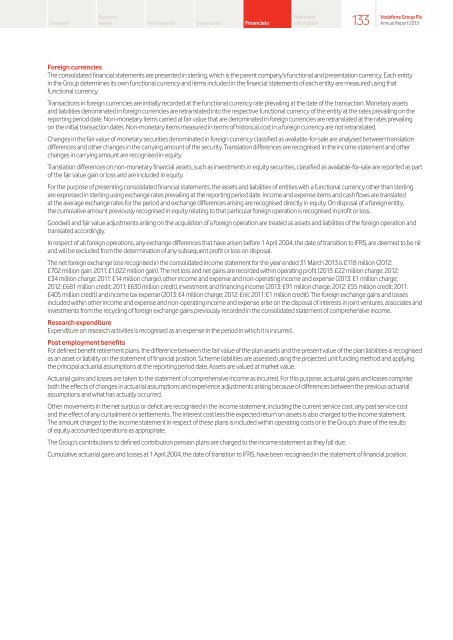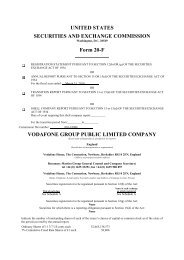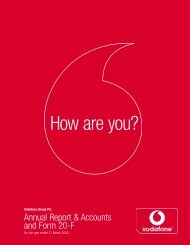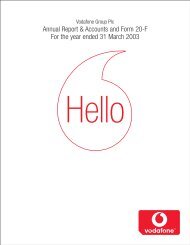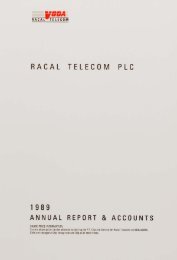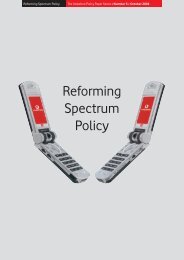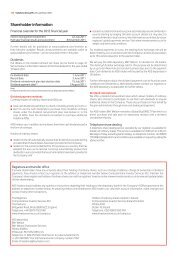The way ahead? - Vodafone
The way ahead? - Vodafone
The way ahead? - Vodafone
Create successful ePaper yourself
Turn your PDF publications into a flip-book with our unique Google optimized e-Paper software.
Overview<br />
Business<br />
review Performance Governance Financials<br />
Additional<br />
information<br />
Foreign currencies<br />
<strong>The</strong> consolidated financial statements are presented in sterling, which is the parent company’s functional and presentation currency. Each entity<br />
in the Group determines its own functional currency and items included in the financial statements of each entity are measured using that<br />
functional currency.<br />
Transactions in foreign currencies are initially recorded at the functional currency rate prevailing at the date of the transaction. Monetary assets<br />
and liabilities denominated in foreign currencies are retranslated into the respective functional currency of the entity at the rates prevailing on the<br />
reporting period date. Non-monetary items carried at fair value that are denominated in foreign currencies are retranslated at the rates prevailing<br />
on the initial transaction dates. Non-monetary items measured in terms of historical cost in a foreign currency are not retranslated.<br />
Changes in the fair value of monetary securities denominated in foreign currency classified as available-for-sale are analysed between translation<br />
differences and other changes in the carrying amount of the security. Translation differences are recognised in the income statement and other<br />
changes in carrying amount are recognised in equity.<br />
Translation differences on non-monetary financial assets, such as investments in equity securities, classified as available-for-sale are reported as part<br />
of the fair value gain or loss and are included in equity.<br />
For the purpose of presenting consolidated financial statements, the assets and liabilities of entities with a functional currency other than sterling<br />
are expressed in sterling using exchange rates prevailing at the reporting period date. Income and expense items and cash flows are translated<br />
at the average exchange rates for the period and exchange differences arising are recognised directly in equity. On disposal of a foreign entity,<br />
the cumulative amount previously recognised in equity relating to that particular foreign operation is recognised in profit or loss.<br />
Goodwill and fair value adjustments arising on the acquisition of a foreign operation are treated as assets and liabilities of the foreign operation and<br />
translated accordingly.<br />
In respect of all foreign operations, any exchange differences that have arisen before 1 April 2004, the date of transition to IFRS, are deemed to be nil<br />
and will be excluded from the determination of any subsequent profit or loss on disposal.<br />
<strong>The</strong> net foreign exchange loss recognised in the consolidated income statement for the year ended 31 March 2013 is £118 million (2012:<br />
£702 million gain; 2011: £1,022 million gain). <strong>The</strong> net loss and net gains are recorded within operating profit (2013: £22 million charge; 2012:<br />
£34 million charge; 2011: £14 million charge), other income and expense and non-operating income and expense (2013: £1 million charge;<br />
2012: £681 million credit; 2011: £630 million credit), investment and financing income (2013: £91 million charge; 2012: £55 million credit; 2011:<br />
£405 million credit) and income tax expense (2013: £4 million charge; 2012: £nil; 2011: £1 million credit). <strong>The</strong> foreign exchange gains and losses<br />
included within other income and expense and non-operating income and expense arise on the disposal of interests in joint ventures, associates and<br />
investments from the recycling of foreign exchange gains previously recorded in the consolidated statement of comprehensive income.<br />
Research expenditure<br />
Expenditure on research activities is recognised as an expense in the period in which it is incurred.<br />
Post employment benefits<br />
For defined benefit retirement plans, the difference between the fair value of the plan assets and the present value of the plan liabilities is recognised<br />
as an asset or liability on the statement of financial position. Scheme liabilities are assessed using the projected unit funding method and applying<br />
the principal actuarial assumptions at the reporting period date. Assets are valued at market value.<br />
Actuarial gains and losses are taken to the statement of comprehensive income as incurred. For this purpose, actuarial gains and losses comprise<br />
both the effects of changes in actuarial assumptions and experience adjustments arising because of differences between the previous actuarial<br />
assumptions and what has actually occurred.<br />
Other movements in the net surplus or deficit are recognised in the income statement, including the current service cost, any past service cost<br />
and the effect of any curtailment or settlements. <strong>The</strong> interest cost less the expected return on assets is also charged to the income statement.<br />
<strong>The</strong> amount charged to the income statement in respect of these plans is included within operating costs or in the Group’s share of the results<br />
of equity accounted operations as appropriate.<br />
<strong>The</strong> Group’s contributions to defined contribution pension plans are charged to the income statement as they fall due.<br />
Cumulative actuarial gains and losses at 1 April 2004, the date of transition to IFRS, have been recognised in the statement of financial position.<br />
133<br />
<strong>Vodafone</strong> Group Plc<br />
Annual Report 2013


